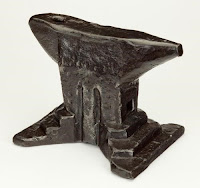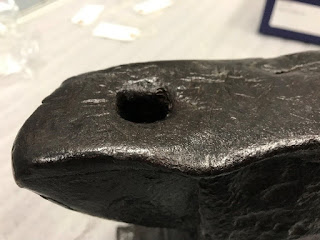 |
"Anvil" (Italian, 1400s-1500s).
Wrought Iron. The John Woodman
Higgins Armory Collection, 2014.1031 |
One afternoon, while looking through the John Woodman Higgins Armory Collection, I discovered a 14
th-century wrought iron anvil. I felt a strong
kinship towards it because I frequently used similar anvils in my metalsmithing
classes in college. The anvil,
arguably more a utilitarian artifact than a work of art in its own right,
seemed to me a relic imbued
with the presence of the often anonymous craftsmen who used it as one of their
most basic and essential tools for shaping arms and armor.
Anvils have
a flat end, a curved tip, and a large flat base that could be secured to a
table or other surface. By varying the
hammer size, force of the blow, and location and angle at which a piece of
metal is struck in relation to the anvil’s top face, an armorer would form the
metal into his desired shape. The large hole in the surface near the flat end
is used to hold other tools for more specialized adjustments (see image 3). The versatility of an anvil to both shape
metal and support other tools made it one of an armorer’s most prized
possessions.
 |
| "Anvil" (Top view) |
My chance
encounter with the anvil made me want to learn more about the hands and tools
that created the objects in the Higgins Armory Collection, especially
in the medieval and renaissance
periods, the years in which this anvil was likely in use.
Through
my exploration, I soon discovered a great deal about the structure of the
armor-making industry. One particularly interesting finding was
that some armorers’ guilds, such as the one in Nuremburg, Germany, required
apprentices to make one or more pieces of armor – such as a helmet or
breastplate – as a test in order to become certified as a full member of the
guild. Afterwards, though the craftsman
could practice independently, he was only allowed to make the specific piece of
armor he fabricated for his
test. This practice no doubt fostered
interdependence by forcing guild members to collaborate with each other. Similarly, there were laws limiting the number of apprentices that a craftsman could have
at one time. This restriction of the
workforce indicates an awareness of the limited market and a desire to regulate
an individual’s production so that everyone could have access to commissions.
 |
| "Anvil" (Detail) |
This
experience exemplifies what I love about art museums: those moments when
interest in an object leads to a greater understanding of an entire society.
-Sydney Kasok, Curatorial Intern, Medieval Art and Arms
& Armor
July 31, 2019
Sources:
Ffoulkes, Charles
John. The Armourer and His Craft from the XIth to the XVIth
Century. London: Methuen & Co, 1912.
Pfaffenbichler,
Matthias. Armourers. Medieval Craftsmen. Toronto: University of Toronto
Press, 1992.
Wattenmaker, Richard
J., Jan Firch, and Alain Joyaux. European Tools from the 17th to the 19th
Century: Woodworking, Metalworking, and Related Trades: Flint Institute of
Arts, April 26-June 7, 1981. Flint, MI: The Institute, 1981.








